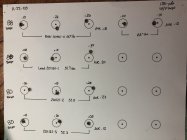A small bit of info...
The original Savage 12 FTR stocks, such as the one featured in the original article, were not bedded but did have 'pillars'... sorta.
The reason I say 'sorta' is because they were much lighter duty than what any gunsmith (that wanted to stay in business) would use... and because there was always a chance of some plus/minus tolerance stacking between the length of the pillar, and how it was fitted in the stock, etc. This usually resulted in one of two situations: either a), the pillar ended up stuck up proud of the wood, one way or another, and the action was just sitting on those very small points of contact (usually not with happy results), or b) the pillar was just ever so slightly below flush, so the receiver body got pulled down flush against the inletting, usually with much better end results. You can probably guess which way the factory tended to err in terms of how they put things together...
So, on an unbedded stock, when torquing the action screws to very specific values, you were effectively controlling how much crush force was applied to the wooden stock - despite it having 'pillars'. There were a few different ways of approaching this. One person (Stan) worked out that torquing the stock bolts in a particular way created repeatable improvements. There was a little more drama to it than that at the time, but the end result worked out very well for him. Another person on the team took a different approach, and would take a new rifle w/ stock and torque the be-jesus out of the stock bolts, and leave it sit for *weeks* like that , and repeat as needed until the bolts no longer turned any more - effectively compressing the wood fibers as far as possible, so in the end, the receiver was both sitting on top of the pillars, and firmly cradled in the inletting.
They both did that to stay within the sponsor's desire at the time to have us shoot 'stock' or as nearly stock as possible, rifles. Me... while I may have eschewed large external modifications as long as possible... pretty much the *first* thing I did was have that stock bedded. While I won't say that there is still no gain to experimenting with torquing the stock bolts to various degrees... I think the effect is severely reduced by having the action properly bedded to the stock.
YMMV,
Monte











